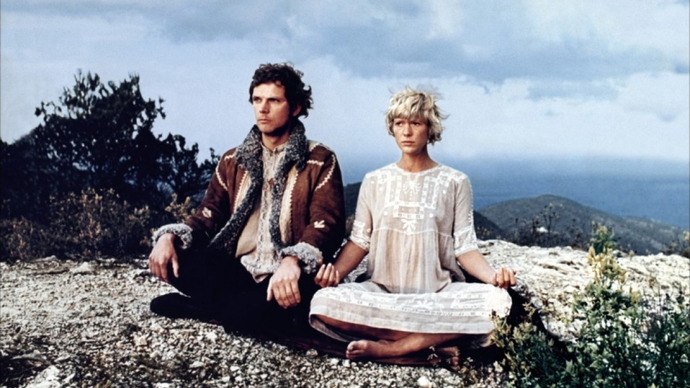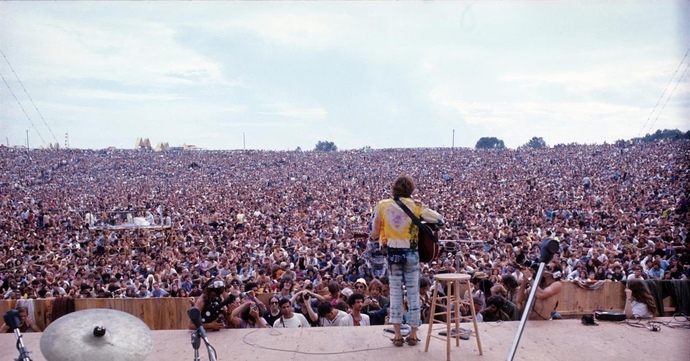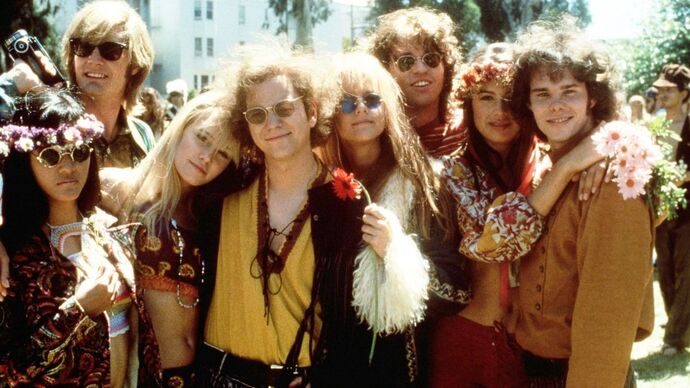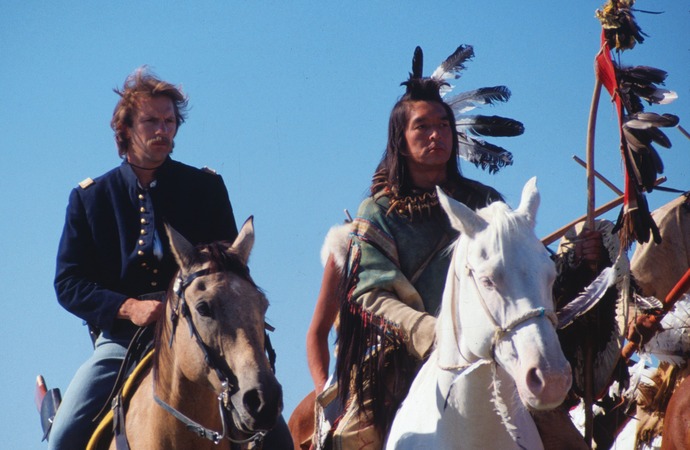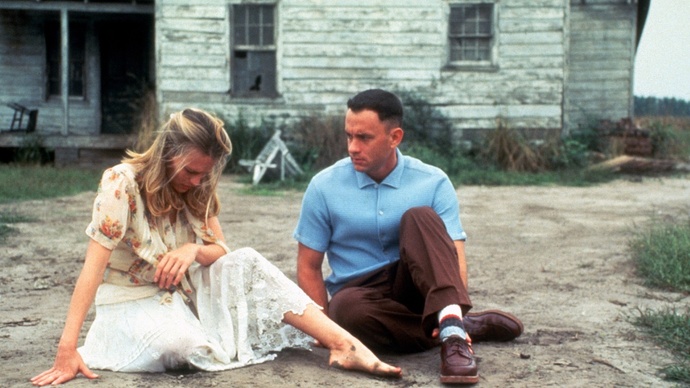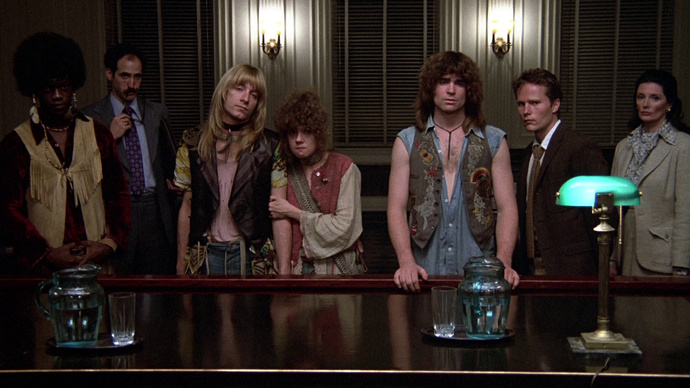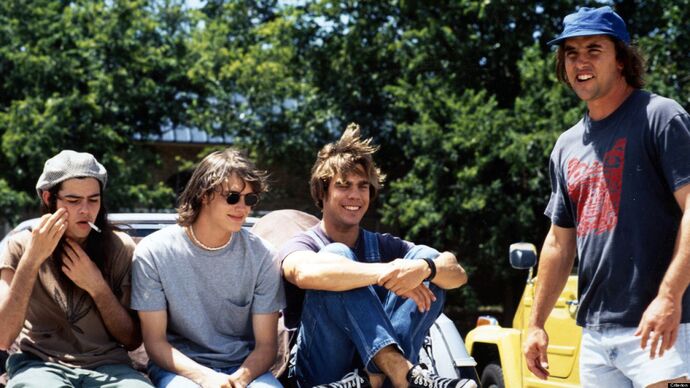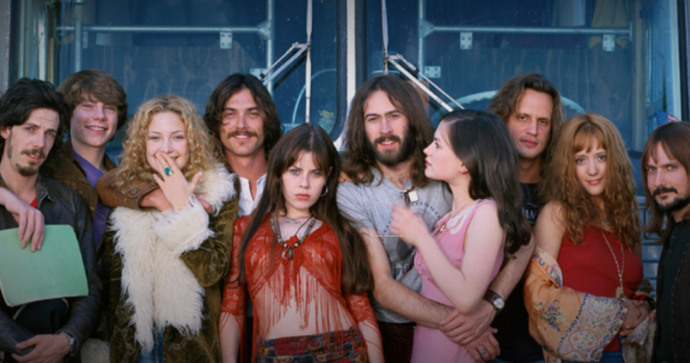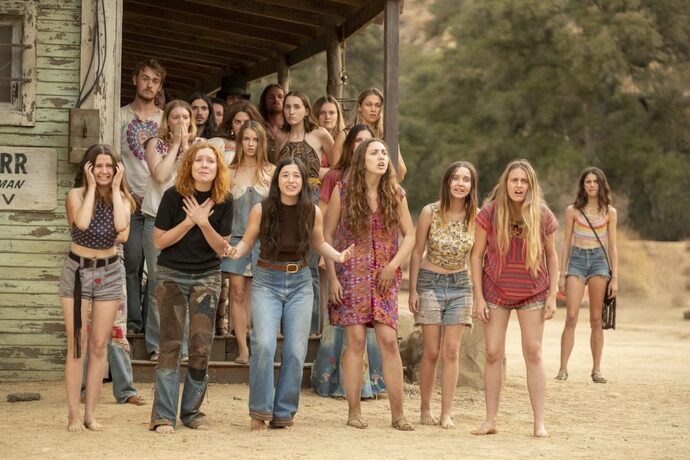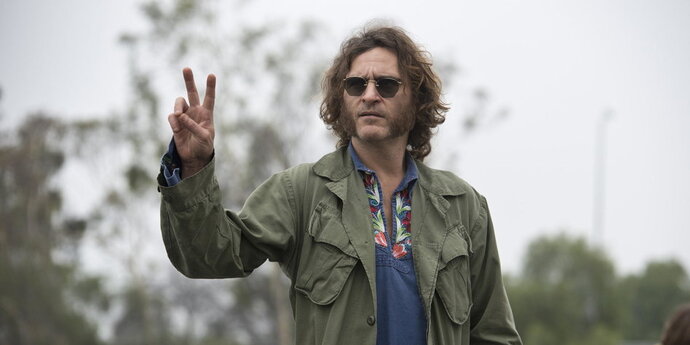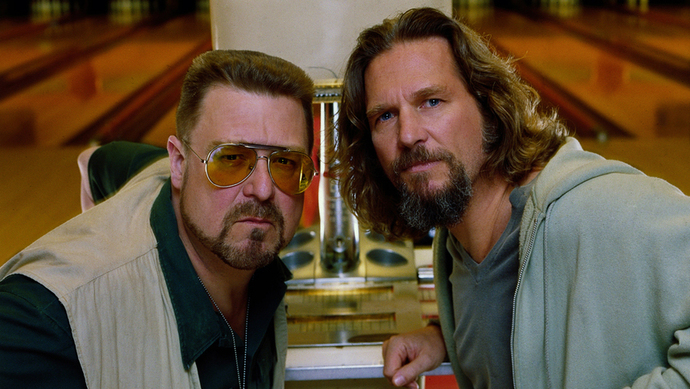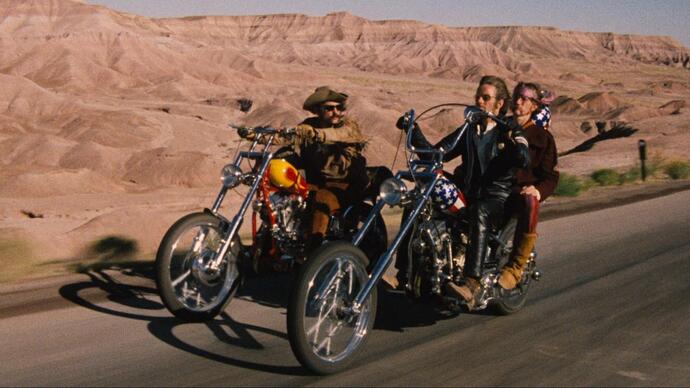Those anti-Vietnam War, pro-LSD stoners took to nature and advocated for free love and spirituality throughout America, sparking a countercultural movement that became a lifestyle identity across the globe. Here are some of the greatest movies in cinema history about hippies and similarly free-spirited characters.
12. More (1969)
A co-production between Germany, France, and England, More shows us the dangers of being a trip-loving hippie. Hitchhiking was an integral part of the yippie lifestyle—and almost as dangerous as the drugs they took. Mathematician Stefan (Klaus Grünberg) has a spiritual awakening after leaving West Germany and meeting the kinky drug addict Estelle (Mimsy Farmer). Of course, begging for heroin wasn’t exactly what the hippie movement was about, but that’s where these pasty-faced lovers end up. The French censorship board wasn’t exactly happy with Barbet Schroeder’s directorial debut and they cut out the hallucinogenic chemical potion they concoct in the kitchen (though the words still appear in the subtitles).
11. Woodstock (1970)
“Hippies” and “Woodstock” are inseparable, with the latter being the biggest musical festival in history, attended mostly by freaks and free lovers. Made up of actual footage from the watershed concert in New York during August 1969, Woodstock won the Academy Award for Best Documentary Feature. Directed by Michael Wadleigh alongside seven editors, Woodstock gained a cult following for its brilliant cinematic execution. Woodstock festival is emblematic of the infamous Summer of Love, featuring performances from Janis Joplin, The Who, and Jefferson Airplane. Oh, and Jimi Hendrix, who got his own spin-off album Live at Woodstock. In 2009, an extended version of Woodstock was released for its 40th anniversary. Besides the fashion and drugs, music is what defined the era… and you can find it all here!
10. The Doors (1991)
Val Kilmer gave the performance of a lifetime as Jim Morrison, lead singer of The Doors and 1960s sex symbol. Morrison was essentially the Marilyn Monroe of the Swinging Sixties without all the LSD. Through Oliver Stone’s movie and various first-hand accounts, we can see all the textbook signs of a personality disorder. Even without the acid, Morrison was known for his eccentric behavior and nonsensical monologues. Tripping in the desert and taking part in blood rituals were Morrison’s favorite past times, and half his photoshoots show dilated pupils. Morrison loved to flirt with death, up until he joined the 27 Club in 1971 (alongside other hippie legends like Janis Joplin and Jimi Hendrix). Hippies are all about living larger than life and expanding the mind, which Stone explores through the ultimate boho rebel in The Doors.
9. Dances With Wolves (1990)
Dances With Wolves technically doesn’t feature any hippies—in fact, it takes place on the Western Frontier in 1863. That said, Lt. John J. Dunbar does learn a lot about his own soul from his Sioux neighbors as they teach him how to reconnect with nature and live freely. When a Union Army Lieutenant finds himself at a Civil War outpost, he learns to tolerate and learn from his spiritual Native American residents. “Dances With Wolves” is the new name given to Dunbar by the Sioux as he sheds his military uniform in favor of feathers and deerskin. Kevin Costner stars in his directorial debut, which remains one of the only Westerns to win the Academy Award for Best Picture. Definitely the best film in Kevin Costner’s Western canon!
8. Forrest Gump (1994)
Forrest Gump himself isn’t a yippie, but the love of his life is. A bad childhood leaves Jenny (Robin Wright) praying to be made into a bird and “fly far, far away”—and she spends the rest of the movie chasing that freedom. This comes in the form of music, drugs, sexual liberation, and, most of all, becoming a full-fledged hippie whos hitchhikes via campervans to anti-war protests. Ironically, Forrest is speaking at the same rally in military uniform! After years of being on the road, abused and addicted, Jenny finally comes home to Forrest. They have a true hippie wedding—barefoot in the grass while wearing a flower crown—until Jenny leaves again and Forrest runs a marathon for 422 days. Besides the endlessly quotable performance from Tom Hanks, Forrest’s life story wouldn’t be half as interesting if it wasn’t for the 1960s subtext unfolding behind it: the Vietnam War, the Black Panthers, the Summer of Love, and a groovy soundtrack.
7. Hair (1979)
Most anti-war movies are about the Vietnam War as thousands of young American soldiers died on foreign soil without justifiable cause. Legendary directors like Stanley Kubrick and Francis Ford Coppola made some of those great Vietnam War movies, but none were musicals. None except one: Miloš Forman’s Hair. A comedy-drama based on the Broadway musical Hair: The American Tribal Love-Rock Musical, the film Hair follows a draftee who’s taken in by a gang of hippies in New York City. Music is often one of the main pillars in any counterculture movement, and that was certainly true for hippies. They also grew their hair long as a symbolic act of rebellion, nonconformity, and embracing of nature. Forman’s fun adaptation resists the cheesy in favor of a rocking 1960s memoir. What better way to express one’s freeness than through music?
6. Dazed and Confused (1993)
Dazed and Confused features long-haired misfits cruising through Texas in 1976. They might not be taking mushrooms naked in a field at Woodstock, but this laid-back gang of teens still embodies the attitudes of a hippie. Not named after the Led Zepplin song (as most people assume), Dazed and Confused is the ultimate stoner movie that meanders through smoke sessions and teen parties at its own pace. You can almost smell the incense. Dazed and Confused was a box office flop that later garnered a huge cult following. Richard Linklater’s coming-of-age comedy features a friendship group we wouldn’t mind being a part of, with our favorite stoner in Ron Slater (Rory Cochrane) who rambles his inner thoughts in a scally cap.
5. Almost Famous (2000)
Almost Famous is another 1970s coming-of-age comedy, but with a sprinkling of drama as it focuses on a “square” child prodigy who enters the world of sex, drugs, and rock n’ roll. Hippie women got a bad reputation for being junkies and groupies who followed and slept with band members on the road. William Miller (Patrick Fugit) is introduced to this wild side of life by Penny Lane, a barely legal groupie with whom everyone falls in love. Almost Famous was Kate Hudson’s breakout movie. Besides all the cheating, overdoses, and fake friendships, Almost Famous is a charming movie about making connections through music. The “Tiny Dancer” sing-along scene will make you want to learn guitar and pile in a van with all your mates.
4. Once Upon a Time in Hollywood (2019)
California was the melting pot for hippies back in the day. While Hollywood has always been preoccupied with bright lights and movie starlets, barefoot nomads could still always be found with their thumb in the air. Once Upon a Time in Hollywood shows us the glitz and glamour of showbiz as well as the dusty communal lifestyle of neighboring hippies. When stunt double Cliff Booth (Brad Pitt) picks up a young hitchhiker, she leads him to their Spahn Ranch where Westerns were once filmed. Hippies might seem to be the most kind and easy-going folk around, but many were indoctrinated by the serial killer cult leader Charles Manson. In Once Upon a Time in Hollywood, Cliff and Rick Dalton (Leonardo DiCaprio) find themselves up against such hippies, all while tripping on an LSD-laced cigarette. And it all leads into the kind of blood-splattered ending you’d expect in any other film directed by Quentin Tarantino.
3. Inherent Vice (2014)
The word “detective” usually calls to mind a whiskey-drinking noir investigator who lingers in the shadows while wearing his trench coat and hat, puffing on a cigarette. Larry “Doc” Sportello of Inherent Vice couldn’t be further from that stereotype. Doc (Joaquin Phoenix) is your stereotypical hippie—barefoot, sideburns, always stoned—except he’s getting on a little. Most of the 20-something hippies he knew have moved on with real jobs, but Doc still lives alone in his beach house solving crimes. Director/writer Paul Thomas Anderson has proven his skill for period pieces, and Inherent Vice is no exception as it captures the mood and texture of a dusky 1970s Los Angeles.
2. The Big Lebowski (1998)
We can safely say The Dude is the number one hippie character in cinema, considering he’s inspired a whole religion created after him. (Seriously, there are over 450,000 ordained and practicing “Dudeist” Priests today.) Jeffrey Lebowski is still Jeff Bridges’s most iconic role, who strolled through the black comedy with a zoot and White Russian in hand. Directors Joel and Ethan Coen open to The Dude shopping in his sunglasses, gown, and slippers—the standard look of your self-accepting loser. Lebowski might not be a straight-up hippie, but he certainly lives like one, doing whatever he pleases while shrugging through life, high and happy, letting life unfold around him without stress or resistance. And if the psychedelic dream sequence isn’t hippie, then we don’t know what is!
1. Easy Rider (1969)
We’re selecting Easy Rider as our number one hippie movie. Why? Because even though the characters aren’t technically hippies, the characters embody similar countercultural ideals—and the film changed cinema forever. Along with Bonnie and Clyde (1967) and The Graduate (1968), Easy Rider marked the dawn of the New Hollywood era. Dennis Hopper directs this landmark indie flick, painting an accurate portrait of the social landscape in which hippie culture rose to prominence. Dennis Hopper stars with Peter Fonda as two bikers smuggling cocaine into Los Angeles. Wyatt and Billy are used to the road and smoking marijuana, but LSD is a new thing for them. Stopping at a “free love” hippie commune, the two leave with a hallucinogenic parting gift. Wyatt and Billy consume the acid while in a graveyard during a Mardi Gras festival, which obviously becomes overwhelming. The pair’s bad trip is creatively portrayed on screen, putting us in their shoes through lens flares, double exposure shots, and layers of ambiguous audio.
